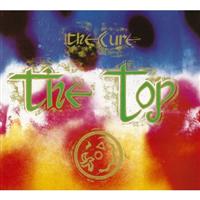Long missing from the US catalog of everyone’s favorite moody goths, this reissue of The Top fills in a void in the CD discography of the Cure—since it was never issued on CD in the US in the first place. But many Cure fans who are hearing it for the first time will find it a puzzling listen. Twenty-two years after its issue, it remains a profoundly unsettled disc that documents a band in transition (and indeed, a band mostly consisting of one member, Robert Smith himself).
My previous review in the Cure reissue series, of last year’s rerelease of Faith, noted that “the darkness that flowered on Faith is what many still consider to be the Cure’s classic sound,” and while that sound is in evidence here, there are a number of other sounds as well—for better or worse. For one thing, the percussion is surprisingly tame for a Cure release, particularly on songs like “Birdmad Girl,” which has a backing track that could have come from any number of 80s acts. The excellent booklet claims that the following track, “Wailing Wall,” was strongly influenced by Smith’s work with Siouxsie and the Banshees, and its atmospherics are appropriately menacing. Other tracks sound familiar in reverse: I found myself wondering if Nick Cave had been listening to “Piggy in the Mirror” when he made “Abattoir Blues,“ the effect is so similar. And the use of the Prophet, that staple of Peter Gabriel’s 1980s recordings, on “Dressing Up” makes the song feel familiar (if dated).
The one track to surface from this album with which I was previously familiar was “The Caterpillar,” which made an appearance on the Staring at the Sea compilation. But where on that release it made a clear connection with other Cure songs like “Lovecats,” “In Between Days” and “Close to Me,” on The Top it stands alone. Yes, the other tracks on the album each have their distinct sound, but nothing prepares you for “The Caterpillar”: the scratchy violin intro, the over-the-top fey vocals, the skittering piano part. This is “happy Cure,” the other personality that is locked inside Robert Smith’s head alongside the glum Morlock, and it still brings a smile after 22 years.
It’s even more amazing that that song crept onto the album when you consider the circumstances of the recording sessions: Laurence Tolhurst drunk or drugged out, Smith himself a few inches from hospitalization (literally—the follow-up tour had to be cancelled thanks to a bad case of blood poisoning), and the rest of the band hardly in the studio (Smith played a lot of this album, except for the drums, himself). In that context, “Caterpillar” seems absolutely miraculous, as does the band’s subsequent revitalization on The Head on the Door.
Bonus material on this deluxe reissue includes the usual assortment of demos and live tracks, including some quite strong demos for never-before-heard songs. My personal favorite, “Happy the Man,” looks forward to Disintegration’s “Last Dance” in its harmonic language even as its lyrics and verbal imagery elude understanding, and was released in its final form as a b-side to “The Caterpillar.”
An essential release? No. But also undeserving of its tag (from Smith himself) of “worst Cure album ever.” There’s a lot on The Top to like.

